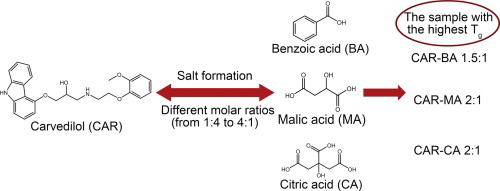Organic acids as co-formers for co-amorphous systems – Influence of variation in molar ratio on the physicochemical properties of the co-amorphous systems

Co-amorphous drug delivery systems are attracting increasing attention in the pharmaceutical field, due to their promising potential to improve the solubility and bioavailability of poorly water-soluble drugs. In this study, three organic acids, namely benzoic acid, malic acid and citric acid and, were investigated as co-formers for the weakly basic drug carvedilol. It was hypothesised that the mono-, di- and triprotic nature of the organic acids could result in co-amorphous salt formation with carvedilol at the respective stoichiometric molar ratios, leading to different physicochemical properties of the co-amorphous samples. The carvedilol-organic acid samples were spray dried at molar ratios from 1:4 to 4:1 and amorphous products were obtained for all mixtures except for carvedilol-benzoic acid at a molar ratio of 1:4. A positive deviation of the glass transition temperature compared to the Gordon-Taylor equation was seen for all co-amorphous samples. Salt formation was confirmed by FTIR, but interestingly complete salt formation did not simply follow the molar ratio of the number of basic and acidic groups, most likely due to steric hindrance.As more than one molecule of carvedilol was found to be involved in most co-amorphous systems with the organic acids, this approach allows for a higher “drug loading” compared to other co-formers that usually form co-amorphous systems at a 1:1 M ratio. In addition, the large number of available organic acids offers various options for selecting co-formers.

